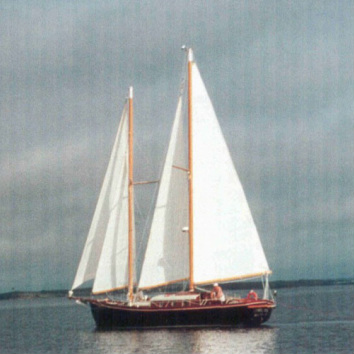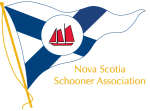
Santorina
Rig: Staysail Schooner
LOA: 45'
LOD: 37' 11"
LWL: 34'
Beam: 11' 5"
Draft: 6'
Weight 28000 lb
Ballast 8,000 lb
SailArea (100%) 774 sq.ft
Built: Covey Island Boat Works - Petite Riviere , Nova Scotia - Launched 1998
Designer: Steve Killing
Power . .2 x 42 hp. Peugeot Diesel
Homeport: Chester, Nova Scotia
This 38-foot schooner incorporates a number of unique features requested by the owner that required careful planning from the outset. The basic parameters of the boat were not a problem—38 feet overall, moderate beam and a draft of five feet, six inches. The client, an engineer from Nova Scotia, owned a smaller schooner for which he had designed and built many modifications. There was no questioning his talent, the real question was, could two creative forces, the designer and owner, co-exist? This was not just idle musing, for I was selected as designer only after two others had been rejected. Although initially disappointed that I was not one of the first two, I took pride in this ultimate show of confidence.
The boat will be used for local cruising on the east coast of Canada, and must be able to comfortably head south, where its horizons will not be limited. A primary influence on the design was the owner’s desire to install twin diesel engines. Rather than following the standard practice of squashing the engine under the companionway, we decided to locate both engines in the forward accommodation area to make them totally accessible for maintenance. This location also permitted a direct shaft line to propellers located in the well-protected area, just forward of the trailing edge of the keel. However, two 410-pound Peugeot diesels located under the galley and head counters profoundly influenced the center of weigh for the entire boat and something in my basic approach had to change. No longer would my rules of thumb for locating the ballast be sufficient. A more detailed weight study (the fear of every designer) was required to determine the appropriate position. With the summary of weights for the boat complete, one would normally locate the keel and ballast, choose the sailplan and then plant it on the deck, but the ballast situation, unusual as it was, held nothing to the sailplan. It also was not in my standard repertoire nor, as it turned out, in anyone else’s.
The sailplan began life as a ketch— two masts with the forward one taller and carrying the bulk of the sail area. This type of rig comes to the forefront for short-handed sailing (the owner intends to do a fair bit), as each individual sail is smaller and can be handled with relative ease. But the owner and I both shared a bias toward a taller aft mast in order to get enough sail area to make the spar worthwhile. A shorter forward mast was a secondary benefit to the more evenly distributed sail area. While these discussions were going on, the ballast/keel issue sat in neutral, waiting for a sailplan to place above the boat. As the aft mast grew in height, the romance of the word “schooner entered the discussion, and for no other reason, the aft mast stretched taller than the forward mast, and the boat became a schooner.
Steve Killing
Rig: Staysail Schooner
LOA: 45'
LOD: 37' 11"
LWL: 34'
Beam: 11' 5"
Draft: 6'
Weight 28000 lb
Ballast 8,000 lb
SailArea (100%) 774 sq.ft
Built: Covey Island Boat Works - Petite Riviere , Nova Scotia - Launched 1998
Designer: Steve Killing
Power . .2 x 42 hp. Peugeot Diesel
Homeport: Chester, Nova Scotia
This 38-foot schooner incorporates a number of unique features requested by the owner that required careful planning from the outset. The basic parameters of the boat were not a problem—38 feet overall, moderate beam and a draft of five feet, six inches. The client, an engineer from Nova Scotia, owned a smaller schooner for which he had designed and built many modifications. There was no questioning his talent, the real question was, could two creative forces, the designer and owner, co-exist? This was not just idle musing, for I was selected as designer only after two others had been rejected. Although initially disappointed that I was not one of the first two, I took pride in this ultimate show of confidence.
The boat will be used for local cruising on the east coast of Canada, and must be able to comfortably head south, where its horizons will not be limited. A primary influence on the design was the owner’s desire to install twin diesel engines. Rather than following the standard practice of squashing the engine under the companionway, we decided to locate both engines in the forward accommodation area to make them totally accessible for maintenance. This location also permitted a direct shaft line to propellers located in the well-protected area, just forward of the trailing edge of the keel. However, two 410-pound Peugeot diesels located under the galley and head counters profoundly influenced the center of weigh for the entire boat and something in my basic approach had to change. No longer would my rules of thumb for locating the ballast be sufficient. A more detailed weight study (the fear of every designer) was required to determine the appropriate position. With the summary of weights for the boat complete, one would normally locate the keel and ballast, choose the sailplan and then plant it on the deck, but the ballast situation, unusual as it was, held nothing to the sailplan. It also was not in my standard repertoire nor, as it turned out, in anyone else’s.
The sailplan began life as a ketch— two masts with the forward one taller and carrying the bulk of the sail area. This type of rig comes to the forefront for short-handed sailing (the owner intends to do a fair bit), as each individual sail is smaller and can be handled with relative ease. But the owner and I both shared a bias toward a taller aft mast in order to get enough sail area to make the spar worthwhile. A shorter forward mast was a secondary benefit to the more evenly distributed sail area. While these discussions were going on, the ballast/keel issue sat in neutral, waiting for a sailplan to place above the boat. As the aft mast grew in height, the romance of the word “schooner entered the discussion, and for no other reason, the aft mast stretched taller than the forward mast, and the boat became a schooner.
Steve Killing

